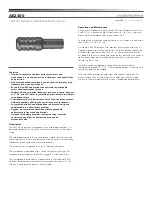
artist elite
®
live sound microphones
AE2300
Cardioid Dynamic Instrument Microphone
Features
• Tailored to capture sound from guitar amps, brass and
woodwinds, drums and percussion instruments with equal clarity
and precision
• Proprietary double-dome diaphragm construction improves high-
frequency and transient response
• Excels in high-SPL applications and maintains directionality
across the entire frequency range
• Minimal off-axis coloration (frequency response is nearly identical
at 0°, 90°, and 180°) helps to maintain phase coherence in multiple
microphone setups
• Switchable low-pass filter removes harsh, high-frequency content
without negatively affecting the overall tone of an instrument
• Low-profile design allows microphone to be placed easily and
unobtrusively in a wide variety of setups
• Rugged, brass metal construction ensures dependable
performance in live music applications
• Isolation stand clamp provides secure mounting, versatile
positioning, and effective dampening of unwanted
mechanical noise
Description
The AE2300 is a dynamic microphone with a cardioid polar pattern. It is
designed specifically for musical instrument pickup in the studio and on
stage.
The cardioid polar pattern of the microphone is more sensitive to sound
originating directly in front of the element, making it useful for controlling
feedback and reducing pickup of unwanted sounds.
The output of the microphone is a 3-pin XLRM-type connector.
The microphone is equipped with a switch that permits choice of flat
response or high-frequency roll-off (via integral 6 kHz low-pass filter).
The microphone is enclosed in a rugged housing. The included AT8471
isolation clamp permits mounting on any microphone stand with
5
/
8
"-27
threads. A soft protective pouch is also included.
Operation and Maintenance
Output is low impedance (Lo-Z) balanced. The signal appears across Pins
2 and 3; Pin 1 is ground (shield). Output phase is “Pin 2 hot”— positive
acoustic pressure produces positive voltage at Pin 2.
To avoid phase cancellation and poor sound, all mic cables must be wired
consistently: Pin 1-to-Pin 1, etc.
An integral 6,000 Hz low-pass filter provides easy switching from a flat
frequency response to a high-end roll-off. The roll-off position reduces the
pickup of high-frequency noise, such as hiss from a guitar amp or high-
hat bleed into the snare sound. To engage the low-pass filter, use the end
tip of a paperclip or other small pointed instrument to slide the switch
toward the “bent” line.
Avoid leaving the microphone in the open sun or in areas where
temperatures exceed 110° F (43° C) for extended periods. Extremely high
humidity should also be avoided.
Take care to keep foreign particles from entering the windscreen. An
accumulation of iron or steel filings on the diaphragm, and/or foreign
material in the windscreen’s mesh surface, can degrade performance.


